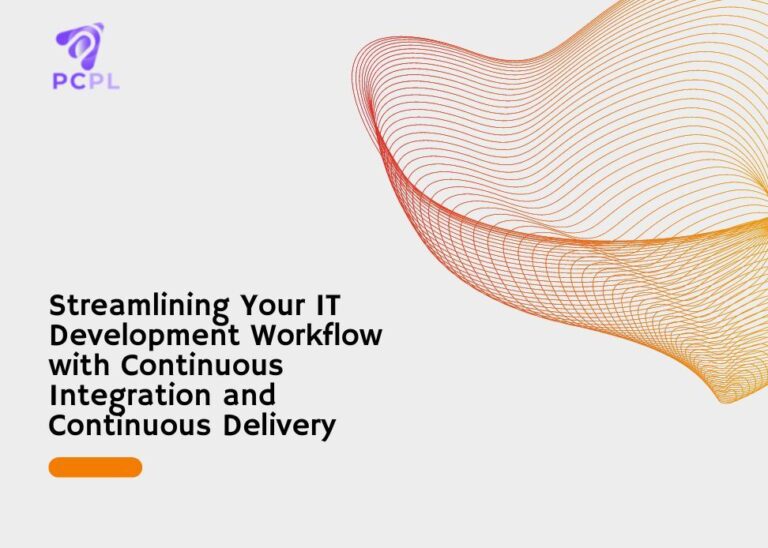
Streamlining Your IT Development Workflow with Continuous Integration and Continuous Delivery (CI/CD)
Efficiency and speed are the two most important things for IT products and solutions to be successful today. And so to keep up with market demands and stay ahead of the competition, organizations need to streamline their development workflows.
Continuous Integration (CI) and Continuous Delivery (CD) are two key practices that enable teams to achieve this by automating and integrating various aspects of the development process.
What is Continuous Integration (CI)?
Continuous Integration (CI) is a practice where developers continuously integrate their code changes into a shared repository. Each integration is automatically tested and validated to detect any issues as early as possible.
The main goals of CI are to
- Detect and fix bugs early in the development cycle.
- Improve code quality.
- Reduce integration problems and conflicts.
Key Components
- Automated Builds– Every time a code change is committed, an automated build process is triggered. This ensures that the new code integrates seamlessly with the existing codebase.
- Automated Testing– Automated tests are run to verify that the new code does not break existing functionality. This can include unit tests, integration tests, and other types of automated tests.
- Version Control– A version control system (e.g., Git) is used to manage code changes and maintain a history of code versions.
What is Continuous Delivery (CD)?
Continuous Delivery (CD) takes the concepts of CI a step further by automating the deployment process. With CD, code changes are automatically prepared for release to production, ensuring that the software can be deployed to any environment at any time.
The main goals of CD are to
- Deliver new features as well as updates quickly and reliably.
- Reduce the risk of deployment failures.
- Provide a consistent and repeatable deployment process.
Key Components
- Deployment Pipelines– Automated pipelines are used to build, test, and deploy code changes. These pipelines ensure that every change is tested and validated before it reaches production.
- Environment Management– CD involves managing multiple environments (e.g., development, staging, production) to ensure that code changes are tested in environments that closely resemble production.
- Automated Rollbacks– In case of deployment failures, automated rollback mechanisms ensure that the system can quickly revert to a stable state.
Why is CI/CD Important?
Staying competitive requires more than just innovative ideas, it demands efficiency, reliability, and speed in bringing those ideas to life. Continuous Integration (CI) and Continuous Delivery (CD) are pivotal in achieving these goals. CI/CD is crucial for modern IT development because of the following reasons-
- Accelerates Development Cycles
CI/CD practices significantly speed up the development process. By automating builds, tests, and deployments, teams can focus on writing code and innovating rather than spending time on manual integration and deployment tasks. This leads to shorter development cycles and quicker release of new features.
- Enhances Product Quality
Automated testing at each stage of integration and delivery ensures that code changes are thoroughly vetted. This consistent testing approach catches bugs early, maintains code quality, and reduces the chances of defects making it to production. High-quality code leads to more reliable products and better user experiences.
- Improves Collaboration and Communication
CI/CD builds a culture of collaboration and communication within development teams. Regular code integration and automated testing encourage developers to share their work frequently and address issues collaboratively. This collaborative approach reduces silos and ensures that all team members are aligned and aware of the project’s progress.
- Reduces Risk and Increases Reliability
Automated deployment pipelines and continuous testing reduce the risk of deployment failures. With CI/CD, each change is validated in a production-like environment before it goes live, ensuring reliability. Additionally, automated rollback mechanisms allow for quick recovery in case of failures, minimizing downtime and impact on users.
- Enables Continuous Feedback and Improvement
CI/CD enables continuous feedback loops by allowing teams to deploy changes to production frequently. This frequent deployment cadence allows for immediate user feedback, which can be quickly incorporated into subsequent releases. Continuous improvement based on real user data enhances the product’s relevance and user satisfaction.
- Supports Agile and DevOps Practices
CI/CD is a cornerstone of Agile and DevOps methodologies, which emphasize iterative development, collaboration, and automation. By implementing CI/CD, organizations can fully embrace these practices, leading to more adaptive, responsive, and efficient development processes.
- Scalability and Flexibility
CI/CD pipelines can be easily scaled and adapted to accommodate different projects and team sizes. Whether you’re a small startup or a large enterprise, CI/CD practices can be tailored to fit your specific needs, allowing your development processes to grow and evolve alongside your organization.
- Boosts Customer Satisfaction
Ultimately, the goal of any software development process is to deliver a product that meets or exceeds customer expectations. CI/CD practices ensure that new features, improvements, and bug fixes reach customers faster and more reliably. This consistent delivery of value enhances customer satisfaction and loyalty.
Benefits of CI/CD
Implementing CI/CD practices offers several benefits that can transform your development workflow, like
- Faster Time to Market
CI/CD automates many manual processes, allowing teams to release new features and updates more frequently. This means that your product can reach the market faster, giving you a competitive edge.
- Improved Code Quality
With automated testing and continuous integration, code quality is consistently maintained. Bugs and issues are detected early, reducing the risk of defects in the final product.
- Reduced Deployment Risks
Automated deployment pipelines and environment management reduce the risk of deployment failures. Continuous Delivery ensures that code changes are thoroughly tested and validated before reaching production, minimizing the chances of downtime or issues.
- Enhanced Collaboration
CI/CD fosters collaboration among team members by encouraging frequent code integrations and automated testing. Developers can work on different features simultaneously without worrying about integration conflicts.
- Greater Agility
CI/CD practices enable teams to respond quickly to changing market demands and customer feedback. With shorter release cycles, you can implement changes and improvements more rapidly.
Implementing CI/CD in Your Workflow
To successfully implement CI/CD in your development workflow, consider the following steps-
- Choose the Right Tools
There are various CI/CD tools available, such as Jenkins, GitLab CI/CD, CircleCI, and Travis CI. Choose tools that best fit your team’s needs and integrate seamlessly with your existing development environment.
- Automate Testing
Automate as many tests as possible, including unit tests, integration tests, and end-to-end tests. This makes sure that code changes are completely validated before deployment.
- Create Deployment Pipelines
Set up automated deployment pipelines to build, test, and deploy code changes. Define stages for different environments (e.g., development, staging, production) and ensure that each stage includes necessary validation steps.
- Monitor and Iterate
Continuously monitor your CI/CD pipelines and gather feedback from your team. Identify areas for improvement and iterate on your processes to enhance efficiency and reliability.
Choose PCPL for CI/CD and your DevOps Needs
Choosing the right partner for your DevOps journey is crucial to achieving seamless integration, efficient workflows, and continuous delivery of high-quality software. Perspicientia Consultancy Private Limited (PCPL) stands out as a leading provider of DevOps platforms, offering comprehensive solutions tailored to your specific needs.
Choosing PCPL means partnering with a team of experts dedicated to transforming your development and operations processes. With our expertise, customized solutions, comprehensive services, and unwavering commitment to your success, PCPL is the ideal choice for organizations looking to embrace DevOps and achieve continuous delivery of high-quality software.
